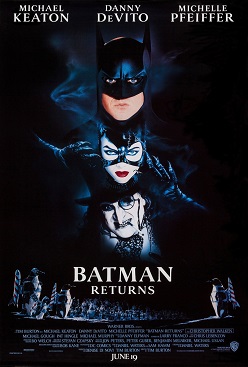Introduction:
In the realm of superhero cinema, few films have ventured into the shadows with the audacity and artistry displayed by “Batman Returns,” released in 1992 and directed by Tim Burton. This gothic masterpiece not only deepened the shadows of Gotham City but also carved a unique niche in the superhero genre by infusing elements of noir, surrealism, and operatic drama. As we embark on this comprehensive review, join us in unraveling the layers of “Batman Returns” and exploring its dark and daring descent into the heart of Gotham’s noir landscape.
I. Plot Overview:
“Batman Returns” delves into the chaotic and sinister underbelly of Gotham City as the enigmatic vigilante, Batman (Michael Keaton), finds himself entangled in a web of treachery and malevolence. The narrative introduces new adversaries: the seductive and vengeful Catwoman (Michelle Pfeiffer) and the grotesque, power-hungry Penguin (Danny DeVito). As their paths intersect, Gotham becomes a battleground for revenge, political intrigue, and a struggle for the city’s soul.
A. Character Dynamics:
- Explore the dynamic between Batman and his newfound foes, Catwoman and the Penguin.
- Analyze the psychological depth of each character, unraveling their motivations and moral ambiguities.
B. Noir Elements in Storytelling:
- Delve into the noir storytelling techniques employed, including morally ambiguous characters and a dark, brooding atmosphere.
- Discuss how the narrative weaves intricate layers of political corruption, personal vendettas, and the eternal struggle between good and evil.
II. Cast and Performances:
A. Michael Keaton as Batman/Bruce Wayne:
- Assess Michael Keaton’s reprisal of the iconic role of Batman/Bruce Wayne.
- Explore Keaton’s portrayal, examining how he navigates the complexities of Batman’s internal conflicts and moral dilemmas.
B. Michelle Pfeiffer as Catwoman/Selina Kyle:
- Analyze Michelle Pfeiffer’s mesmerizing transformation into Catwoman/Selina Kyle.
- Discuss Pfeiffer’s performance, highlighting the character’s duality and the exploration of feminine empowerment in the film.
C. Danny DeVito as the Penguin/Oswald Cobblepot:
- Examine Danny DeVito’s grotesque and compelling portrayal of the Penguin/Oswald Cobblepot.
- Discuss how DeVito brings nuance to a character that oscillates between sympathy and repulsion.
D. Christopher Walken as Max Shreck:
- Evaluate Christopher Walken’s portrayal of the enigmatic and Machiavellian Max Shreck.
- Explore how Walken adds a layer of corporate malevolence to the film’s narrative.
III. Directorial Vision:
A. Tim Burton’s Unique Vision:
- Assess Tim Burton’s directorial vision in shaping the dark and surreal aesthetic of “Batman Returns.”
- Discuss Burton’s signature gothic style, exploring how it enhances the film’s atmosphere and thematic depth.
B. Visual Design and Cinematography:
- Delve into the film’s visual design, including the intricate sets and costume design.
- Analyze the cinematography’s role in creating a visually captivating and thematically rich noir landscape.
C. Score and Soundtrack:
- Examine the impact of Danny Elfman’s evocative score on the film’s tone and emotional resonance.
- Discuss how the soundtrack complements the visual elements, contributing to the overall cinematic experience.
IV. Noir Themes and Symbolism:
A. Dark and Brooding Atmosphere:
- Explore how the film establishes a dark and brooding atmosphere characteristic of classic film noir.
- Discuss the visual and narrative choices that contribute to the film’s noir ambiance.
B. Symbolism in Character Design:
- Analyze the symbolism embedded in the character designs, especially for Catwoman, Penguin, and Batman.
- Discuss how visual symbolism adds layers of meaning to the characters’ arcs and the overall narrative.
V. Critical Reception and Cultural Impact:
A. Critical Acclaim:
- Examine the critical reception of “Batman Returns” upon its release.
- Discuss how critics responded to the film’s departure from traditional superhero narratives and embrace of noir elements.
B. Cultural Impact and Legacy:
- Explore the lasting impact of “Batman Returns” on the superhero genre.
- Discuss how the film’s bold approach to storytelling and aesthetics has influenced subsequent superhero films.
VI. Gender Dynamics and Feminism:
A. Exploration of Feminist Themes:
- Delve into the feminist themes explored through the character of Catwoman.
- Discuss how “Batman Returns” subverts traditional gender dynamics and contributes to discussions of female empowerment in cinema.
B. Representation of Women in Noir:
- Analyze how the film navigates the representation of women within the noir genre.
- Discuss the complexities of Catwoman’s character as she grapples with societal expectations and her own agency.
VII. Controversies and Artistic Liberties:
A. Controversies Surrounding the Film:
- Address any controversies that arose in response to the film’s darker and more mature themes.
- Discuss how the film’s departure from a conventional superhero narrative sparked discussions about artistic liberties in the genre.
VIII. Conclusion:
In conclusion, “Batman Returns” (1992) stands as a testament to the artistic daring and narrative innovation that can be achieved within the superhero genre. Tim Burton’s directorial vision, coupled with stellar performances from the cast, elevates the film beyond mere superhero spectacle, crafting a gothic and noir-infused narrative that challenges conventions and resonates with audiences. As we traverse the shadowed streets of Gotham with Batman, Catwoman, and the Penguin, we find ourselves immersed in a cinematic experience that transcends the boundaries of traditional superhero storytelling. “Batman Returns” is a dark and daring descent into the heart of Gotham’s noir, leaving an indelible mark on the landscape of superhero cinema and continuing to captivate audiences with its timeless allure.
